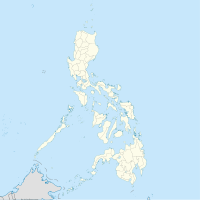Bangcud is an urban barangay in the South Highway District of Malaybalay City, Bukidnon, in the Philippines.[3]
Bangcud | |
|---|---|
| Coordinates: 7°59′29.6″N 125°08′15.5″E / 7.991556°N 125.137639°E | |
| Country | Philippines |
| Province | Bukidnon |
| City | Malaybalay |
| District | South Highway District |
| Barangayhood | 1935 |
| Government | |
| • Type | Barangay Council |
| • Body | Sangguniang Barangay |
| • Chairman | Estela A. Edma |
| Area | |
• Total | 15.75 km2 (6.08 sq mi) |
| Elevation | 346.8 m (1,137.8 ft) |
| Population (2015) | |
• Total | 5,111 |
| • Density | 320/km2 (840/sq mi) |
| PSGC | 101312002[1] |
| IRA (2020) | Php 4,988,571[2] |
Location
editIt is bounded to the north by Cabangahan, to the east by the Sawaga River which separates it from Simaya and Santo Niño, to the south by the Manupali River which separates it from Colonia and Mailag of Valencia City, and to the west by Kulasihan of the municipality of Lantapan. According to the 2015 census, Bangcud has a population of 5,111 people.[4][5] It has an area of 1,575 hectares (15.75 km2),[3] subdivided into seven purok. Bangcud is mostly flat and is surrounded by three rivers, the Kulasihan, Manupali, and Sawaga, where the confluence of the latter two marks Bangcud's southernmost point.
Economy
editAgriculture is the primary economic activity; sugarcane, maize, and rice are among the primary crops produced. There is also a sizable commercial activity as Bangcud is situated on the crossroads to Malaybalay City proper, Basakan District, and Valencia City. Bangcud is known for its two foremost tourist attractions, the Matin-ao and Nasulî Springs.[3] These are natural springs popular for their cool and clear waters, which appear blue in deeper parts. Bangcud Central School and Bangcud National High School are the main public schools in the barangay, both of which are within District VII.[6]
History
editBangcud comes from the Cebuano word "bangkò" which means chair, referring to a boulder along the Manupali that resembles a chair. The village was then incorporated as a sitio of Mailag. In 1935, Bangcud was separated from Mailag as a regular barrio and remained as part of Malaybalay when Mailag was separated from Malaybalay to form the municipality of Valencia in 1959.[7]
References
edit- ^ "Philippine Standard Geographic Code for Bangcud". Philippine Statistics Authority.
- ^ "CY 2020 Monthly internal revenue allotment for barangays, Region X, Bukidnon". Department of Budget and Management.
- ^ a b c "BANGCUD – THE CITY GOVERNMENT OF MALAYBALAY". Retrieved May 12, 2020.
- ^ "Bangcud, Malaybalay, Bukidnon Profile – PhilAtlas". www.philatlas.com. Retrieved May 12, 2020.
- ^ "Total Population by Province, City, Municipality and Barangay" (PDF). Philippine Statistics Authority. Archived (PDF) from the original on October 22, 2015.
- ^ "Division of Malaybalay City Map". DepED, Division of Malaybalay City. October 20, 2012. Retrieved May 12, 2020.
- ^ "CREATING THE MUNICIPALITY OF VALENCIA IN THE PROVINCE OF BUKIDNON". Official Gazette. Archived from the original on May 14, 2021.

